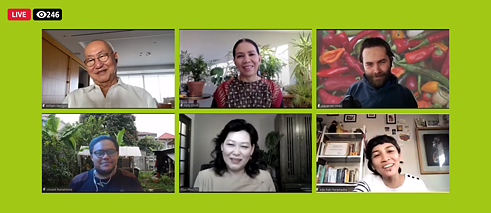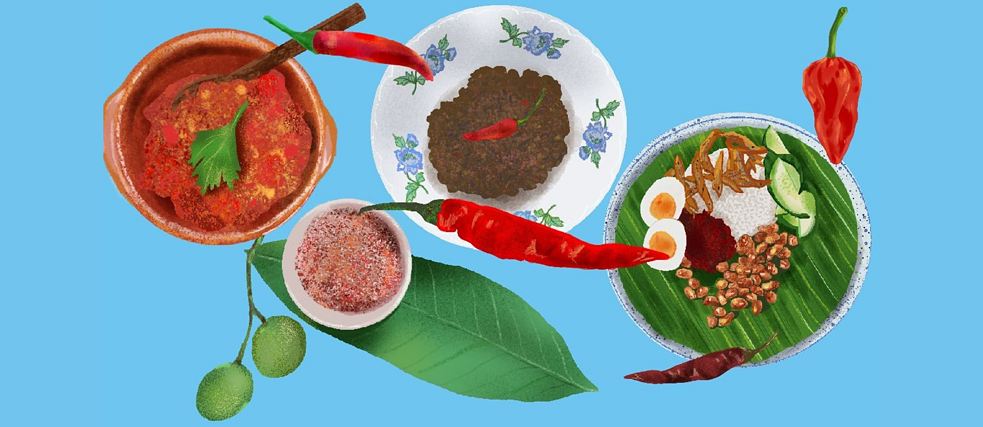Chili Culture in Southeast Asia and Germany

As part of the “Goethe is(s)t scharf” project, the Jakarta Goethe-Institut joined with those in Bandung, Bangkok and Yangon to host an online discussion on the topic of “Chili Culture in Southeast Asia and Germany”.
For the talk, a multi-national collection of experts and professionals from Indonesia, Myanmar and Germany that included William Wongso, Petty Elliot, Vincent Rumahloine, Alexander Hicks, and Daw Phyu Phyu Tin gathered online to share their knowledge of food cultures, and in particular of those that relate to chili, all under the skillful moderation of Ade Putri Paramadita.
Chilies are not just a food, and in Southeast Asia, they form a core part of the cultural fabric, giving the region’s gastronomy its distinctive features and marking and creating major differences between individual areas within the broader region. In the case of Indonesia, chilies can even have important economic impacts, and rising chili prices can push up inflation, lifting the cost of food, drinks and tobacco. Given the broad and deep importance of chili to the region, the discussion was not limited just to talk about how spicy this or that chili is, but rather, by investigating how cultures of chili consumption affect people in a range of different ways, the discussion extended over much more fertile ground.
Sambal: Spiciness and memory
Sambal, an Indonesian chili paste, has put down deep historical roots in Indonesian culinary culture, and as William Wongso explained, sambal is what Indonesians first think of when they think of food. Indonesians are in fact so attached to sambal that when they travel, whether they’re going near or far, they’ll often take a jar of their favorite blend with them. Indeed, this spicy paste has become such a key feature of daily life, that you can’t really separate one from the other.According to Vincent Rumahloine, sambal embodies and reflects the connections that exist between the individual and the shared memories that each sambal-eater has for their community and its inhabitants. Sambal is thus a medium for linking the eater with where they are and where they come from, which perhaps helps to explain the Indonesian saying, “A good wife makes good sambal”.
Petty Elliot spoke about the role of chili in non-chili eating cultures, warning that you have to adjust how much chili you use when preparing food for others in light of how much of it they normally eat. Thus, when you make food for westerners, you need to reduce the spiciness of the food, which will then help people from non-chili-based food cultures get used to it. In Myanmar, people eat spicy food in much the same way as in Indonesia. They eat fresh chili, powdered chili, and chili paste, and they use chili as a condiment, a preserve and as an ingredient, but depending on the type of dish being prepared, you need to choose between fresh and dried varieties. Daw Phyu Phyu Tin also explained how eating chili makes people feel like they’re back at home. For both Indonesians and Myanmarese, chili plays a role as a mediator or carrier of feelings and memories, of ideas about the role of women, and of home, society and the nation.
Chili: Exploring the world through communities of spice
Before he was even a year old, Alexander Hicks, a German chili expert and connoisseur, had his first encounter with chili when his parents gave him some Mexican salsa to eat. Europeans are familiar with peppers from eating pizza and food from Greece, but in fact peppers come from South America, from where they spread to Europe and then on to Southeast Asia. We can now trace these historical paths and by following these, we can explore the world and peek into the kitchens of people from a huge range of different ethnic groups. Exploring the world of chili might make some nostalgic or homesick, but it might help others learn, perhaps including how to cook spicy foods, though you’ll need to work out how much heat you can handle.Alexander’s interest in chili extends to its cultivation, and he now has a seedbank of hundreds of different types of chili from around the world. This has then opened the way to connect with others who share his passion, and from this a network and community of chili-lovers has developed, within which members exchange their chili stories and expertise. This ranges from the everyday to the esoteric, though sometimes it can be even as hot as the chilis they love to discuss!
Vincent Rumahloine also described his research into how music might help chilis grow. Using ideas drawn both from modern science and technology and from older, traditional ecological thinking that is based on the belief that plants and animals belong to a particular place and that each has its own inner spirit, Vincent has carried out experiments to investigate the effect of music on chili growth. Projects like this thus represent another way in which people and communities join together to build educational networks, both in Indonesia and overseas.
What can you do to get rid of that spiciness?
Participants in the discussion shared their secrets for what to do when you eat something that’s just too hot, but it turns out that people in different countries have slightly different ways of dealing with this. In Indonesia, people recommend drinking warm (not cold!) water, coconut juice or milk, or eating a spoonful of sugar or some yoghurt, but in Myanmar, people prefer to drink black tea or eat some jaggery, while in Germany, the cure is more beer.Chili and food: Ways of life
The importance of the various roles played by chili is reflected in the divergent cultures and ways of life we find in Indonesia, Myanmar and Germany. The growing culture of chili appreciation that we touched on earlier is also helping to build networks and communities, and to underpin projects that connect onwards to other areas and contexts. Chilies and spicy food are still there to be eaten, though, and consuming these presents the possibility of opening the way to new culinary experiences and through this, connecting eaters to feelings, memories and many more aspects of life; the wonder of chilies is how they give us all different but equally fiery memories that we can then look back on.Watch recorded live here
Further info about this event

